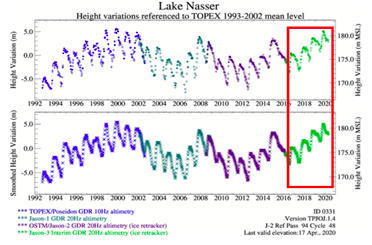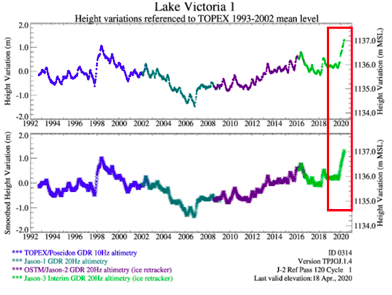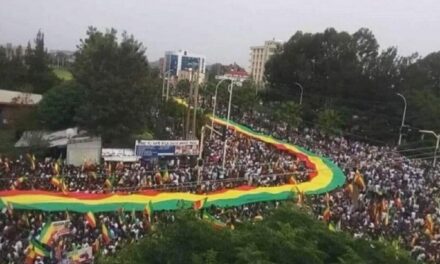By: Essayas Kaba, Ph.D., Geospatial Scientist; Feyera Aga Hirpa, Ph.D., Flood Data Scientist; Semu Moges, Ph.D., P.E, Water Resource Scientist, The Water-Energy-Food Nexus Team
Ethiopia is in preparation to commence the filling of the Grand Ethiopian Renaissance Dam (GERD) in July 2020, the middle of the wet season across Ethiopian highlands. It is the right time to start filling the dam. Three important hydrological conditions that strongly favor such a plan are: the increased water storage in the High Aswan Dam (HAD), the higher than average seasonal rainfall in Ethiopia and the upper Nile, and increased water storage in the Equatorial Lakes.
The high water storage in the High Aswan Dam (HAD)
The water level at the HAD (Lake Nasser) in Egypt has been steadily increasing since 2016 (post the 2015 drought) and is currently at 2.87 meters above its 10 years mean water level (usda.gov, 2020a). The satellite radar altimetry data from the United States Department of Agriculture’s Foreign Agricultural Service; usda.gov, 2020a) shows the current water level is higher than 88% of the maximum lake water levels observed since 1992 (Figure 1). The increased storage in HAD provides a favorable buffering effect to compensate the portion of the water stored in the GERD as the filling commences in the next wet season.

The seasonal high rainfall
Above-average rainfall has been observed from January through May across Ethiopian highlands and the upper Nile. Furthermore, the seasonal outlook of the next wet season months (June-September) also shows a wetter increase compared to the long-term average rainfall. The IGAD Climate Prediction and Applications Centre (ICPAC) forecast release for June-September 2020 (ICPAC, 2020) shows (Figure 2), most of the Horn of Africa receiving summer rainfall is wetter than above long-term mean average (40-60%). The coming wet season combined with the current higher state of water storage in HAD enables the filling of GERD to commence with minimal impact on the HAD reservoir water and downstream water uses. It would be irresponsible to miss this opportunity of relatively higher water abundance compared to other years.

Figure 2: the IGAD Climate Prediction and Applications Centre (ICPAC) June-September 2020 rainfall forecast (ICPAC, 2020)
The rising water level in Lake Victoria
The Equatorial Nile region has experienced heavy rainfall and flooding during the long rainy season (March-May) this year (2020). As a result, the water level in Equatorial Lakes including Lake Victoria, a major contributor to Nile water, has shown a rapid increase (Figure 3). In fact, it has been reported that “the Lake Victoria now is at a record high 13.42 meters” (The Independent (n.d.)), which is higher than the previous high-water mark of 13.41 meters recorded on May 5, 1964 (from a reference gauge). The increased stored water in the Equatorial Lakes this year continues to yield more water to the Nile river than the years with average seasonal rainfall. Consequently, it would be irresponsible to miss this season when the water availability in hydrological systems has clearly increased and when the portion that would be stored in the GERD with the start of the filling would have minimal effect on the water resources of the downstream countries.

In summary, the combination of the rising water level of Lake Nasser, the favorable wet season rainfall, and the raising of Equatorial levels has created an unmissable opportunity to start filling the GERD this wet season. In fact, from the water resources perspective, starting this summer should be in the best interest of all the trans-boundary countries. We believe that all the evidences suggest that this season is the best time to commence filling the dam.
Please send any feedbacks, comments or questions to: [email protected] or [email protected].






thanks DOC you gave us reasonable,
short and precise concepts.
Our determination is calling the universe to answer in our interest. And we thank God for this!
Thank you for sharing this important information with us!
Having these three combinations are rare. That is when God helps you. Egypt should not miss this opportunity to downgrade their treat on Ethiopia and Sudan. Remember we share the river.
Nice. ..nice. .so..nice
Very interesting good job
If you ask for too much at once, you will come home with an empty bag. ~ Croatian Proverbs
I think for Egypt the anticipated shortage of water is only a cover up. The main reason is the political and economic empowerment of Ethiopia as the result of the operation of the dam in its fullest capacity. Ethiopia’s full control of the flow of water which is source of life in Egypt intern shows the power Ethiopia has on Egypt especially in light of its relationship with Israel. This worries Egypt and same token the whole middlest.
Thanks Doc breife and proffesulion!!
First of all thank you for this study, it is relieves some of the pressure and anxiety from me as Egyptian. The question is how long will it take to fill the dam? if you start now it would be a good starting point with minimal impact on Egypt and Sudan, but let’s say one year after the level of water reduces and suddenly Egypt is deprived from water, agriculture and food with the possibility of the death of at least 20 million people as per some of the studies on the impact of water deprivation, what is your comment on this part?
@Abdella Ibrahim what you mentioned is a legitimate concern. However, the water stored in the Aswan dam should be enough to overcome any seasonal draught. With or without the GERD, Egypt will be impacted if a draught hits Ethiopia. With cooperation with Ethiopia (not obligatory), Ethiopia can ensue Egypt gets enough water all the time whether there is draught or not. Egypt cannot hold Ethiopia responsible for any draught that may occur in the future.